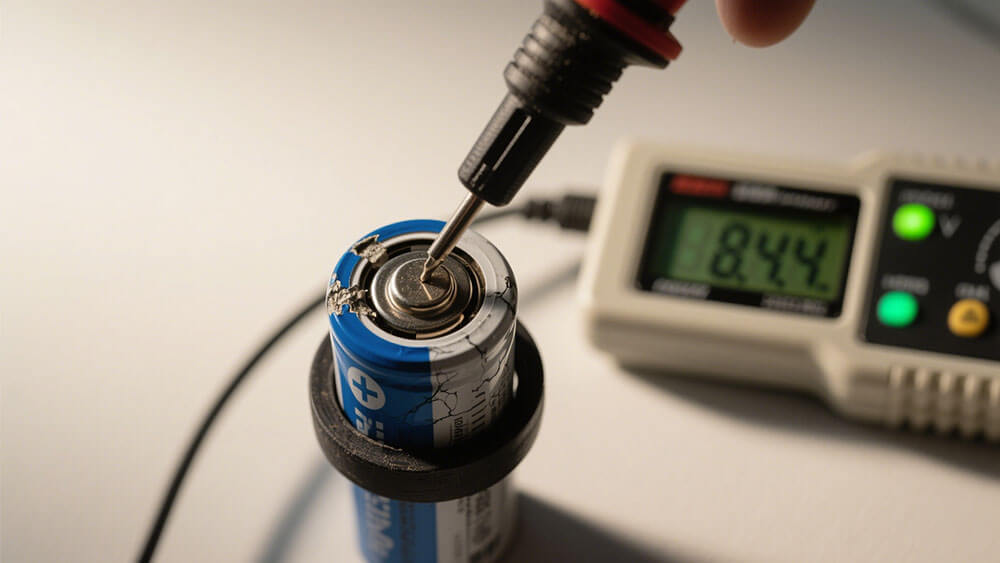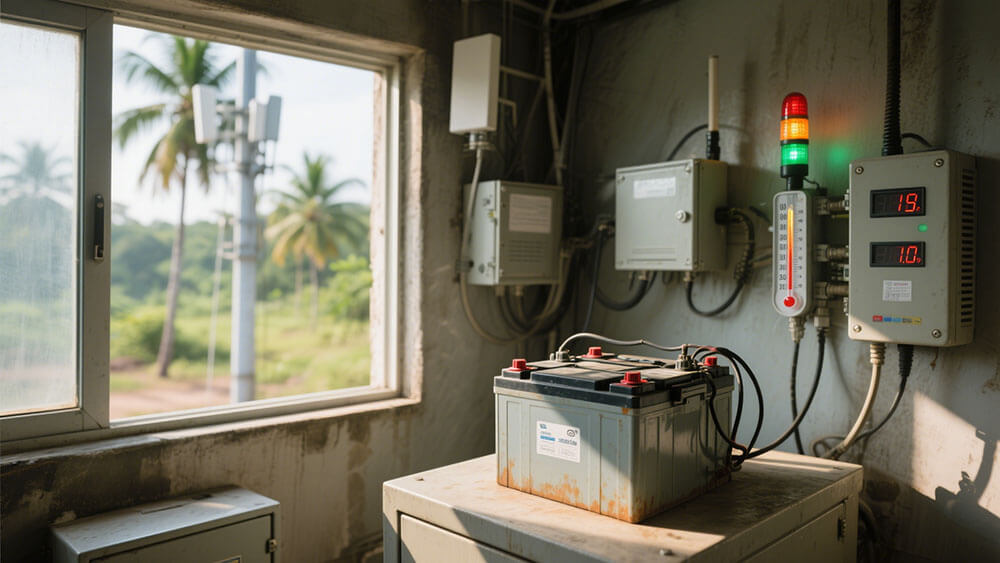
Voltage sag in lithium batteries occurs when the output voltage drops under load, impacting the device’s performance and reliability. For industrial applications, this phenomenon can disrupt operations and reduce system efficiency. Temperature directly influences voltage sag by altering the battery’s internal resistance and chemical stability.
High temperatures accelerate battery degradation and increase safety risks, such as thermal runaway.
Low temperatures cause sluggish ion movement, leading to reduced capacity and efficiency.
Understanding these trends is essential to optimize battery performance and lifespan.
Tip: Effective thermal management can mitigate temperature-induced voltage sag and ensure stable operation. Explore custom solutions tailored to your needs here.
Key Takeaways
Temperature changes affect how lithium batteries work. Hot temperatures wear out batteries faster, and cold temperatures make them harder to use, causing voltage drop.
Use good cooling systems to keep batteries at the right temperature. This helps them work better, lowers voltage drop, and makes them last longer.
Pick the right battery type. LiFePO4 Lithium batteries stay steady in different temperatures and have less voltage drop.
Part 1: Understanding Voltage Sag in Lithium Batteries

1.1 Definition and Causes
Voltage sag in lithium batteries refers to the temporary drop in voltage when the battery is under load. This phenomenon occurs due to increased internal resistance and electrochemical limitations during discharge. You may notice voltage sag more prominently in high-demand applications, such as industrial systems, where batteries must deliver consistent power.
Several factors contribute to voltage sag. The battery’s state of charge (SOC) plays a significant role; lower SOC levels often result in higher voltage drops. Additionally, the effect of temperature cannot be ignored. Extreme temperatures, whether high or low, alter the battery’s chemical reactions and ion mobility, exacerbating voltage sag. The type of lithium battery chemistry also matters. For instance, LiFePO4 Lithium batteries, known for their stability, exhibit less voltage sag compared to NMC Lithium batteries under similar conditions.
Note: Understanding these causes helps you identify the right battery chemistry and operating conditions for your application.
1.2 Implications for Battery Packs
Voltage sag impacts the performance and reliability of battery packs, especially in industrial applications. When voltage drops below the required threshold, devices may malfunction or shut down entirely. This can disrupt operations in sectors like robotics, infrastructure, and consumer electronics.
Battery packs designed for high-demand environments must account for voltage sag. For example, integrating a Battery Management System (BMS) can help monitor and mitigate voltage fluctuations. Additionally, selecting batteries with higher energy density and cycle life, such as NMC Lithium batteries, can reduce the frequency and severity of voltage sag.
Tip: If your application involves robotics or infrastructure, consider consulting experts at Large Power for custom battery solutions tailored to your needs.
Part 2: Effect of Temperature on Voltage Sag

2.1 High-Temperature Impact
High temperatures significantly influence the performance and longevity of lithium batteries. When exposed to elevated temperatures, the internal resistance of the battery decreases, which initially seems beneficial. However, this comes at a cost. Prolonged exposure to high temperatures accelerates chemical reactions within the battery, leading to faster degradation of the electrolyte and electrode materials. This degradation increases the likelihood of voltage sag, especially during high-demand operations.
Empirical studies highlight the risks associated with high temperatures. For instance, research on lithium-ion pouch cells reveals temperature rises of 3 K to 11 K during charging and discharging phases, which directly correlates with performance degradation. Another study on thermal gradients emphasizes the uneven stress distribution within battery cells, further exacerbating voltage sag.
Study | Findings |
|---|---|
Effect of thermal gradients on inhomogeneous degradation in lithium-ion batteries | Highlights the importance of understanding stress factors for predicting battery service life, which is crucial for maintenance and safety. |
Quantifying the effects of temperature and depth of discharge on Li-ion battery heat generation | Investigates heat generation rates under high discharge rates, providing insights into heat accumulation and loss in lithium-ion cells. |
To mitigate these effects, you should consider implementing robust thermal management systems. These systems help maintain the battery within its optimal temperature range, ensuring consistent performance and reducing the risk of voltage sag.
Tip: For industrial applications, consult experts to design custom battery solutions that include advanced cooling mechanisms.
2.2 Low-Temperature Challenges
Low temperatures pose unique challenges for lithium batteries. As the temperature drops, the movement of lithium ions within the electrolyte slows down. This reduced ion mobility increases internal resistance, leading to higher voltage sag and diminished charge/discharge capacity. Additionally, low temperatures can cause the formation of lithium metal on the negative electrode during charging, which further increases impedance and harms battery performance.
Statistical data underscores these challenges:
Standard lithium batteries experience a significant decrease in capacity and energy density at low temperatures.
Membrane impedance and charge transfer impedance increase, further reducing efficiency.
Lithium ions move slower, leading to higher voltage sag and reduced operational reliability.
Charging in cold conditions can result in irreversible damage to the battery’s internal structure.
To address these issues, you should prioritize battery chemistries like LiFePO4 Lithium batteries, which are more stable across a wide temperature range. Additionally, pre-heating mechanisms or insulated enclosures can help maintain the battery’s temperature within its optimal range, ensuring reliable performance even in cold environments.
Note: If your application involves robotics or infrastructure in cold climates, consider consulting Large Power for tailored battery solutions.
2.3 Temperature-Induced Chemical and Physical Changes
Temperature variations induce both chemical and physical changes in lithium batteries, directly affecting voltage sag. At high temperatures, the electrolyte’s ion transportation speed increases, reducing resistance voltage but accelerating diffusion voltage. This imbalance can lead to uneven concentration gradients, which disrupt electrochemical processes and exacerbate voltage sag. Conversely, low temperatures slow down these processes, increasing resistance voltage and reducing overall efficiency.
Aspect | Effect of Temperature |
|---|---|
Battery Resistance | Decreases with higher temperatures due to increased ion transportation speed in the electrolyte. |
Resistance Voltage | Represents the ohmic voltage drop; varies with temperature. |
Diffusion Voltage | Accelerates with higher temperatures, affecting concentration gradients and electrochemical processes. |
Understanding these changes is crucial for optimizing battery performance. You should aim to operate batteries within their optimal temperature range of 15°C to 35°C.
Maintaining this temperature range minimizes chemical imbalances and ensures stable operation. Advanced materials, such as solid-state electrolytes, can also enhance thermal stability and reduce the impact of temperature fluctuations on voltage sag.
Sustainability Note: For more insights into sustainable battery technologies, visit sustainability at Large Power.
Part 3: Experimental Insights on Temperature and Voltage Sag

3.1 Laboratory Findings
Laboratory experiments provide valuable insights into the effect of temperature on voltage sag in lithium-ion batteries. Controlled studies reveal that elevated temperatures between 25°C and 55°C accelerate performance degradation. This temperature range increases the degradation rates of charge storage capacity, charge transfer efficiency, and cell impedance. These degradation modes directly contribute to voltage sag during discharge cycles.
For example, tests on NMC Lithium batteries demonstrate that higher temperatures reduce the electrolyte’s stability, leading to faster chemical reactions. These reactions increase internal resistance and cause uneven current distribution across the battery cells. As a result, the battery’s ability to deliver consistent voltage diminishes under load. Conversely, experiments at low temperatures show reduced ion mobility, which increases resistance and exacerbates voltage sag.
To mitigate these effects, you should consider integrating advanced thermal management systems into battery packs. These systems stabilize the temperature range, ensuring optimal performance and minimizing degradation modes. For industrial applications, consulting experts to design custom solutions tailored to your operational needs can significantly enhance battery reliability.
Tip: Explore custom battery solutions with integrated thermal management systems here.
3.2 Real-World Observations
Field data from industrial operations further illustrate the impact of temperature on voltage sag. Lithium-ion batteries used in high-demand environments often operate outside their optimal temperature range, leading to accelerated degradation. Elevated temperatures increase the breakdown of electrode materials and electrolyte components, reducing charge transfer rates and increasing impedance. These degradation modes result in voltage instability during prolonged use.
For instance, industrial applications such as robotics and infrastructure rely on consistent power delivery. When batteries experience temperature fluctuations, voltage sag disrupts operations and reduces efficiency. In cold climates, low temperatures slow ion movement, causing higher resistance and reduced capacity. These challenges highlight the importance of maintaining a stable temperature range to ensure reliable performance.
To address these issues, you should prioritize battery chemistries like LiFePO4 Lithium batteries, which offer greater thermal stability. Additionally, implementing pre-heating mechanisms or insulated enclosures can help maintain optimal operating conditions. For industries requiring robust solutions, consulting experts for tailored battery designs can provide significant advantages.
Sustainability Note: Learn more about sustainable battery technologies here.
Part 4: Mitigating Temperature Effects on Voltage Sag

4.1 Thermal Management Solutions
Effective thermal management is critical for minimizing the effect of temperature on voltage sag in lithium batteries. By maintaining an optimal temperature range, you can enhance battery performance and reduce the risk of capacity loss. Industrial applications, such as robotics and infrastructure, often demand consistent power delivery, making thermal management systems indispensable.
One of the most effective strategies involves integrating active cooling systems. These systems use liquid or air-based cooling mechanisms to dissipate heat generated during charging and discharging cycles. For instance, liquid cooling systems circulate a coolant through channels within the battery pack, ensuring uniform temperature distribution. This approach minimizes thermal gradients, which can lead to uneven degradation and voltage instability.
Passive cooling methods, such as heat sinks and thermal pads, also play a vital role. These materials absorb and dissipate heat without requiring additional energy input, making them ideal for applications where energy efficiency is a priority. Additionally, pre-heating mechanisms can be employed in cold environments to bring the battery to its optimal operating temperature before use.
A battery management system (BMS) is another essential component for thermal regulation. The BMS monitors temperature in real-time and adjusts charging or discharging rates to prevent overheating or overcooling. This proactive approach not only reduces voltage sag but also extends the overall lifespan of the battery.
Tip: For industrial applications requiring robust thermal management, consider consulting experts to design custom battery solutions tailored to your operational needs.
4.2 Advanced Materials for Stability
The development of advanced materials has revolutionized the thermal stability of lithium batteries, directly addressing the challenges posed by temperature fluctuations. By incorporating innovative materials into battery design, you can significantly reduce the effect of temperature on voltage sag and improve overall safety.
Key Material Innovations:
Evidence Type | Description |
|---|---|
Cathode Modification | Coating cathode materials with oxides (e.g., MgO, Al2O3) enhances thermal stability by isolating the cathode from the electrolyte and reducing internal reactions. |
Thermoresponsive Polymers | Incorporating thermoresponsive polymer switching materials in separators can effectively shut down battery operation under overheating conditions. |
Electrolyte Additives | Adding specific compounds like ethoxy (pentafluoro) cyclotriphosphazene improves the thermal stability of electrolytes, reducing flammability and enhancing safety. |
Cathode modifications, such as oxide coatings, are particularly effective in reducing lithium-ion battery degradation. These coatings act as a barrier, preventing direct contact between the cathode and electrolyte. This isolation minimizes unwanted side reactions, which often accelerate at high temperatures, leading to voltage sag.
Thermoresponsive polymers represent another breakthrough. These materials respond to temperature changes by altering their physical properties. For example, when the battery overheats, the polymer in the separator can expand or contract, effectively shutting down the battery to prevent thermal runaway. This self-regulating mechanism enhances safety and reduces the risk of capacity loss.
Electrolyte additives also play a crucial role. By incorporating compounds like ethoxy (pentafluoro) cyclotriphosphazene, you can improve the thermal stability of the electrolyte. These additives reduce flammability and enhance the battery’s ability to operate within a wider temperature range, ensuring consistent performance even in demanding conditions.
Sustainability Note: Advanced materials not only improve battery performance but also contribute to sustainability by extending battery life and reducing waste. Learn more about sustainable battery technologies here.
By leveraging these material innovations, you can design lithium batteries that are more resilient to temperature variations. This approach is particularly beneficial for industrial applications, where reliability and safety are paramount.
Temperature plays a critical role in the performance of lithium batteries. High temperatures accelerate chemical degradation, while low temperatures increase internal resistance. Both conditions lead to voltage sag, reducing efficiency and reliability. Managing temperature effectively ensures stable operation and extends battery life. You should prioritize innovative solutions and support research to advance battery technology.
FAQ
1. What causes voltage sag in lithium batteries?
Voltage sag occurs due to increased internal resistance and electrochemical limitations during discharge. Temperature fluctuations and battery chemistry also play significant roles.
2. How can you reduce temperature effects on battery performance?
Use thermal management systems like cooling mechanisms or insulated enclosures. Advanced materials and battery chemistries also improve stability under extreme temperatures.
3. Why is temperature management critical for industrial batteries?
Temperature management ensures consistent power delivery, reduces voltage sag, and extends battery lifespan. It is essential for high-demand applications like robotics and infrastructure.
Consider consulting experts to design custom battery solutions tailored to your operational needs.




